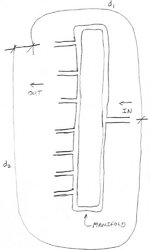I'm about to get my storage tank up and running. It is going to hold 980 gallons and will be rectangular. My current thought on the heat transfer is have two horizontal arrays of parallel copper pipe with manifolds at each end. One array will be at the top of the tank, and the other will be at the bottom. The two arrays will be connected to each other at one set of manifolds. The manifolds at the opposite end of the arrays will connect to the supply and return. I want the flow through the arrays to reverse depending on whether I am adding/taking heat from the tank. If I am adding heat to the tank, hot water comes in the top manifold, travels through the top array to the other end's manifold, travels down the connector pipes to the bottom manifold, travels through the bottom array to the other end's manifold, and then back to the furnace. When taking heat, the water direction is reversed. I think this is a good design and to me it seems by breaking the flow into multiple horizontal pipes, the flow rate drops and I'm getting better heat transfer. I am also thinking the setup will maximize stratification of the tank. As this is all new to me and a lot of you have been through the trial and error before, please critique my idea. If I'm all wrong, it's obviously better for me to know it now rather than after I fab this thing.
My thoughts for storage heat transfer
- Thread starter Lukas060606
- Start date
-
Active since 1995, Hearth.com is THE place on the internet for free information and advice about wood stoves, pellet stoves and other energy saving equipment.
We strive to provide opinions, articles, discussions and history related to Hearth Products and in a more general sense, energy issues.
We promote the EFFICIENT, RESPONSIBLE, CLEAN and SAFE use of all fuels, whether renewable or fossil.


